Uncategorised
The Official 2020 Change Checker Games!
*** UPDATE ***
Like many of you, we were waiting in high anticipation for the Tokyo Olympics this year, but as we had to wait a little longer, we decided to host our very own Change Checker version of events…
And we’ve now chosen our Bronze, Silver and, Gold prize winners! Simply watch our video below to find out if you’ve won…
Every Friday we’ve been running a different coin-based challenge for you to take part in, which you can see on our Facebook page!
Each video showcased a demonstration of the week’s event and all you needed to do to be in with the chance of winning some incredible prizes was:
- Watch our weekly video here
- Have a go at the challenge yourself, and
- Leave a picture or video of your attempt in the comments on our Facebook post!
For each event, we have chosen a Gold, Silver and Bronze winner, who will each be winning a prize!
Simply watch our video in this blog, or on our Facebook page, to find out if you’ve been chosen as one of our winners!
Bronze: a set of three Change Checker Trading Cards to add to your collection!

Silver: a set of SIX Change Checker Trading Cards to add to your collection!

But, last and definitely by no means least, our Gold winners will be taking home an incredible NINE Change Checker Tradings Cards AND a year’s subscription to Coin Collector Magazine!

We are so grateful to Coin Collector Magazine for getting involved, so a huge thank you goes to them!
Our Awards Ceremony video is now live on our Facebook channel and you can see it here.
Thanks so much to everyone who took part and congratulations to our winners!
Don’t forget to send us an email at [email protected] to claim your prize!
If you’re interested in coin collecting, our Change Checker web app is completely free to use and allows users to:
– Find and identify the coins in their pocket
– Collect and track the coins they have
– Swap their spare coins with other Change Checkers

Sign up today at: www.changechecker.org/app
Change Checker Live Coin Bingo!
It’s time to dust off your dabbers because LIVE Coin Bingo is back!

You don’t need to be a bingo buff to get involved, all you need is your 50p collection to hand, our helpful key and your Change Checker bingo sheet.
To get involved just follow these simple steps:
- Gather your 50p collection so that your coins are to hand!
- Download your Change Checker Live Bingo Key and your Change Checker Live Bingo Scorecard print them out!
- Head to our Youtube channel Thursday 19th November, at 12.15 pm and tune in to our LIVE Coin Bingo video.
- When a number is called, check your Bingo Key to see which 50p it corresponds to. If you’ve got this 50p in your collection, place it on your scorecard!
- If you manage to fill all 9 squares with the 50p coins that are called out, take a photo of your completed Bingo Scorecard and email [email protected]
The first person to get ‘BINGO’ and email in, will be winning a Change Checker Album and a set of THREE Trading Cards!
There will also be two runner up prizes of three Trading Cards for the two next complete scorecard owners!
So, start gathering your 50ps, print off your Bingo kit, and tune back in to our Youtube channel, Thursday 19th November, at 12.15pm.
We can’t wait to see you there!
If you’re interested in coin collecting, our Change Checker web app is completely free to use and allows users to:
– Find and identify the coins in their pocket
– Collect and track the coins they have
– Swap their spare coins with other Change Checkers

Sign up today at: www.changechecker.org/app
Your guide to the Pre-1997 50p Coins
In recent years, the 50 pence piece has become the most collected coin in the world.
But here at Change Checker, we get asked a lot about the older specification 50p coins… “How many old 50ps are there to collect? How rare are my old 50ps? Can I still find these coins in circulation?” are just a few of the questions frequently asked.
So, we’ve put together a guide answering your questions and giving you the key facts we think you need to know about these out-of-circulation coins!
What are old specification 50ps?
The 50p emerged in 1969 as the first coin in the new decimal series.
It was also the world’s first seven-sided coin and has since become the most collected coin in the country!
In 1997, the specification for the 50p changed to the size and feel we’re familiar with today.
But, between 1969-1997, there were five 50p coins issued in these older specifications. But what was different about these coins?
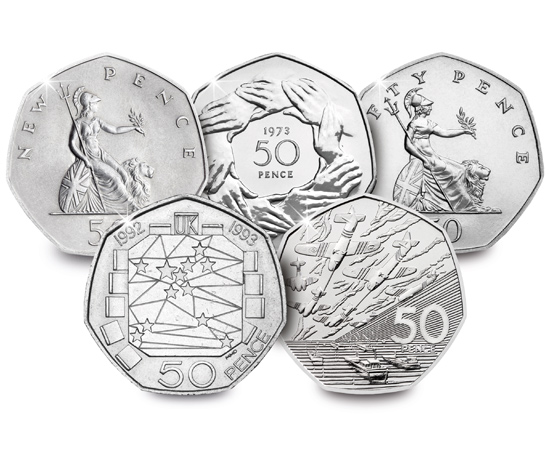
Left to Right: Britannia New Pence, Entry to the EEC, Britannia Fifty Pence, EC Presidency, D-Day
Spot the difference
| Pre-1997 (old specification) | 1998 onwards (new specification) | |
| Weight | 13.05g | 8.00g |
| Diameter | 30mm | 27.30mm |
| Metal | Cupro-Nickel | Cupro-Nickel |
| Obverse Effigy | 1969-1985 – 2nd Portrait, Arnold Machin 1985-1997 – 3rd Portrait, Raphael Maklouf | 1998-2015 – 4th Portrait, Ian Rank-Broadley 2015-onwards – 5th Portrait, Jody Clark |
As you can see, despite the 50p retaining the same metal composition, the older specification was much bigger and heavier than the coin we’re used to today – imagine carrying around a bundle of those in your pockets!
These coins were removed from circulation when the new specifications were introduced, so you won’t come across these in your change.
What’s more, shop keepers and banks won’t accept these as legal tender, so we imagine a lot of these will have been kept by collectors for their private collections!
So, how many of these coins were issued? Let’s take a look at our Pre-1997 50p Mintage Chart and see..
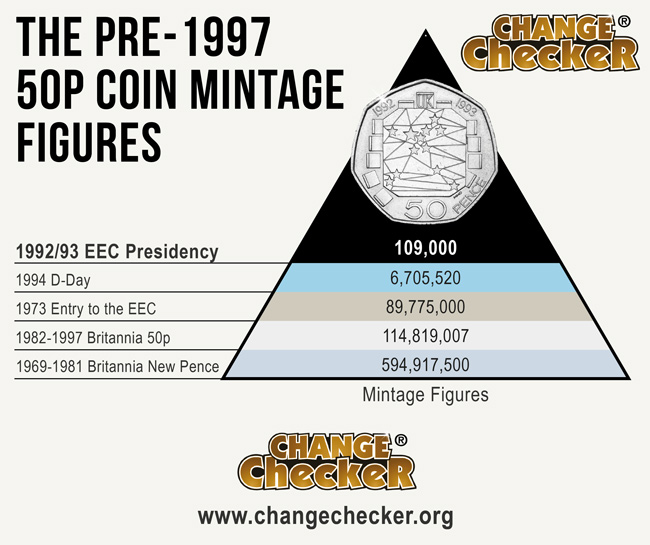
You might have spotted the top coin in our chart has a mintage of JUST 109,000! Let’s take a look at each of these coins in closer detail to get the full story..
1969 Britannia New Pence
Fact File:
- Year of Issue: 1969-1981
- Obverse Designer: Arnold Machin
- Reverse Designer: Christopher Ironside
- Mintage: 594,917,500

The New Pence 50p was the first 50p coin ever issued and it featured Christopher Ironside’s iconic Britannia design.
Britannia first appeared on UK coinage in 1672 and since then has always been present on at least one denomination.
With a mintage of 594,917,500 is the most common of the pre-1997 50p designs, which is hardly surprising as it was the definitive 50p design between 1969-1981.
Despite it’s considerably high circulating mintage, this coin is still considered collectible as it’s no longer in circulation.
1973 Entry to the EEC 50p
Fact File:
- Year of Issue: 1973
- Obverse Designer: Arnold Machin
- Reverse Designer: David Wynne
- Mintage: 89,775,000
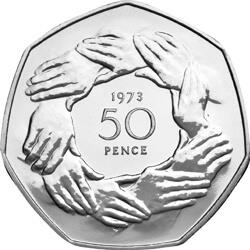
This coin was issued to celebrate the UK’s entry to the EU (then called the European Economic Council or the EEC).
With a mintage of 89,775,000 it is less common that the definitive design but not the rarest out there!
It is still incredibly sought-after by collectors though as this was the FIRST-EVER commemorative 50p!
1982 Britannia Fifty Pence
Fact File:
- Year of Issue: 1982/83/85
- Obverse Designer: Arnold Machin (1982/82) Raphael Maklouf (1985)
- Reverse Designer: Christopher Ironside
- Mintage: 114,819,007

In 1982 the ‘New Pence’ in the design was replaced with ‘Fifty Pence’ as the design was no longer considered new.
Although still the definitive design, this coin was only issued in 1982, 1983 and 1985 and featured two different portraits of Her Majesty on the obverse! Machin in ’82 and ’83 and the new Maklouf portrait in ’85.
With a mintage of 114,819,007, it’s the second most-common of the Pre-1997 50ps.
1992/93 EC Presidency 50p
Fact File:
- Year of Issue: 1992/93
- Obverse Designer: Raphael Maklouf
- Reverse Designer: Mary Milner
- Mintage: 109,000
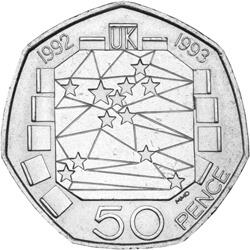
Designed by Mary Milner, this 50p celebrates the UK’s presidency of the European Council of Ministers.
Excitingly, this 50p is the RAREST ever UK 50p to enter circulation. With a mintage of just 109,000 it’s even rarer than the sought-after Kew Gardens 50p which has a mintage of 210,000.
As this coin is no longer in circulation AND has the lowest ever UK 50p circulating mintage, it’s incredibly sought-after by collectors and if you’re lucky enough to have one in your collection, you should be extremely pleased!
1994 D-Day Landings 50p
Fact File:
- Year of Issue: 1994
- Obverse Designer: Raphael Maklouf
- Reverse Designer: John Mills
- Mintage: 6,705,520
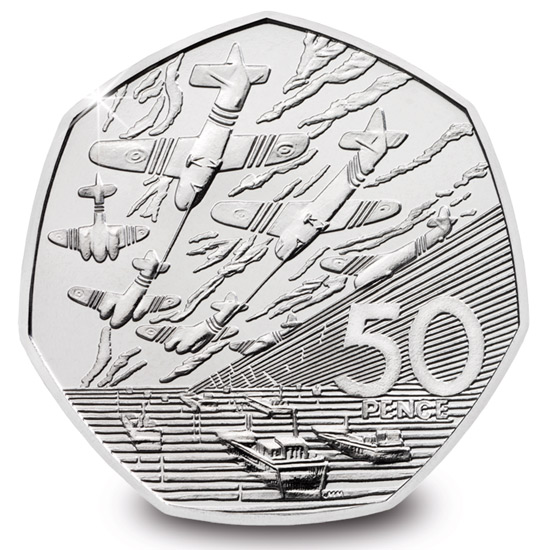
Issued to commemorate the 50th anniversary of the D-Day Landings, this was the final 50p issued in the older specifications.
Interestingly, this has been voted Change Checkers ‘Favourite Ever’ 50p!
With a mintage of 6,705,520 it is the second rarest of the pre-1997 50p coins.
So hopefully our guide to the Pre-1997 50p coins will help you along the way to expanding your collection!
What’s most exciting about all five of these coins is that now they’re out of circulation, they are all considered particularly sought-after by collectors!
Do you have any of these coins in your collection already? Let us know in the comments below!
Own the UK’s FIRST-EVER Commemorative 50p

